Electronics Recycling Market
Electronics Recycling Market Size and Share Forecast Outlook 2025 to 2035
Electronics recycling market is projected to grow from USD 43.2 billion in 2025 to USD 147.9 billion by 2035, at a CAGR of 13.1%. PCs & Laptops will dominate with a 45.0% market share, while dismantling will lead the process segment with a 52.0% share.
Electronics Recycling Market Forecast and Outlook 2025 to 2035
The global electronics recycling market is valued at USD 43.2 billion in 2025. The market is slated to reach USD 147.9 billion by 2035. This records an absolute increase of USD 104.7 billion over the forecast period. The total growth amounts to 242.4%. The market forecast shows expansion at a CAGR of 13.1% between 2025 and 2035.
The market is expected to grow by approximately 3.42X during the same period. Growth is supported by increasing electronic waste generation. Growing environmental regulations drive expansion. Rising precious metal recovery demand supports market development. Consumer electronics replacement cycles accelerate adoption.
Quick Stats for Electronics Recycling Market
- Electronics Recycling Market Value (2025): USD 43.2 billion
- Electronics Recycling Market Forecast Value (2035): USD 147.9 billion
- Electronics Recycling Market Forecast CAGR: 13.1%
- Leading Type in Electronics Recycling Market: PCs & laptops (45.0%)
- Key Growth Regions in Electronics Recycling Market: North America, Europe, and Asia-Pacific
- Key Players in Electronics Recycling Market: Aurubis AG, Attero Recycling, Sims Recycling Solutions, Enviro-Hub, Umicore, Veolia, TES-AMM, Dowa, Raw Materials Company, Recupyl
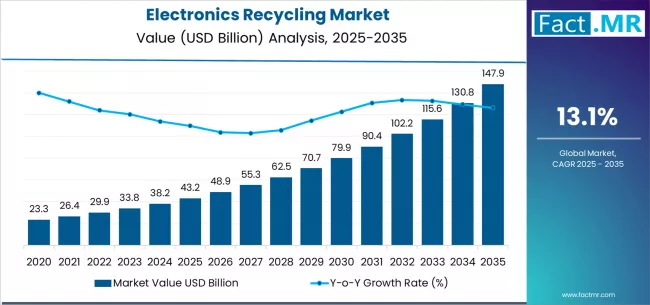
The electronics recycling market represents a specialized segment of the global waste management industry. The market shows rapid technological advancement. Consistent demand exists across circular economy channels. Resource recovery channels drive growth. Market dynamics are influenced by changing regulatory requirements toward comprehensive e-waste management.
Growing interest in critical material recovery shapes development. Expanding partnerships between recycling companies drive growth. Electronics manufacturers in developed economies show increased adoption. Emerging economies demonstrate growing demand patterns. Traditional disposal methods continue evolving. Recyclers seek proven recovery alternatives. Enhanced resource benefits attract industrial users. Reliable processing characteristics remain essential requirements.
Consumer behavior in the electronics recycling market reflects broader sustainability trends. Efficient recycling systems provide functional benefits. Effective systems deliver environmental advantages. The market benefits from growing popularity of circular economy solutions. These systems are recognized for sophisticated material integration. Technical approach to resource recovery gains acceptance.
The versatility of electronics recycling supports multiple applications. Standalone recycling processes serve specific needs. Integrated recovery system components expand market reach. Multiple industrial applications drive demand growth. Technology segments show increased adoption patterns.
Regional adoption patterns vary significantly across global markets. North American markets show strong preference for standardized electronics recycling implementations. European markets demonstrate similar standardization trends. Asian markets show increasing adoption of advanced recycling solutions. Conventional disposal systems remain popular in developing regions.
The industrial landscape continues evolving with sophisticated products. Quality-controlled electronics recycling products gain traction in mainstream applications. Industrial applications reflect processor willingness to invest in improvements. Proven recycling system enhancements attract investment. Performance-oriented features drive adoption decisions.
The competitive environment features established waste management companies. Specialized recycling solution providers focus on unique capabilities. Advanced processing methods drive differentiation. Recovery efficiency remains critical for market participants. Product development optimization continues as key factor. Raw material costs create ongoing challenges.
Quality standardization requirements fluctuate regularly. Distribution strategies emphasize multi-channel approaches. Traditional waste supply chains combine with direct partnerships. Technical service platforms expand market reach. Supply distribution agreements strengthen customer relationships.
Market consolidation trends indicate acquisition strategies by larger manufacturers. Waste management manufacturers acquire specialized recycling companies. Product portfolio diversification drives acquisition activity. Access to specialized recovery system segments motivates purchases. Private label development has gained momentum. Industrial companies seek differentiation opportunities. Competitive pricing structures remain important considerations.
Specialized electronics recycling variants emerge in the market. High-recovery options reflect changing processor priorities. Advanced-processing options create new market opportunities. Innovative recycling system developers benefit from emerging trends. Processing automation enables consistent recovery scaling. Quality control improvements maintain traditional performance characteristics. Processors expect established performance from recycling system brands.
Between 2025 and 2030, the electronics recycling market projects expansion from USD 43.2 billion to USD 95.5 billion. This results in a value increase of USD 52.3 billion. The increase represents 50.0% of the total forecast growth for the decade. This development phase will be shaped by increasing adoption of automated processing systems. Rising demand for precious metal recovery drives growth.
Critical material extraction gains market acceptance. Growing emphasis on circular economy characteristics supports expansion. Enhanced recovery capabilities attract users. Processing operators expand recycling capabilities. Growing demand for specialized electronics recycling implementations continues. Advanced processing options gain popularity. Industrial offerings across technology segments increase.
Electronics Recycling Market Key Takeaways
| Metric | Value |
|---|---|
| Estimated Value (2025E) | USD 43.2 billion |
| Forecast Value (2035F) | USD 147.9 billion |
| Forecast CAGR (2025-2035) | 13.10% |
From 2030 to 2035, the market is forecast to grow from USD 95.5 billion to USD 147.9 billion. This adds another USD 52.4 billion. The addition constitutes 50.0% of the overall ten-year expansion. This period is expected to be characterized by expansion of advanced separation technologies. Integration of artificial intelligence continues. Development of specialized electronics recycling implementations occurs.
Enhanced recovery profiles gain importance. Extended processing capabilities attract users. Growing adoption of blockchain tracking will drive demand. Electronics recycling with superior recovery characteristics gains acceptance. Compatibility with Industry 4.0 technologies across processing operations expands.
Between 2020 and 2025, the electronics recycling market experienced explosive growth. Digital transformation acceleration drove development. Growing recognition of electronics recycling as essential services supported expansion. Critical material shortage programs across industries gained momentum. Resource security applications showed growth. The market developed as processors recognized potential benefits.
Electronics recycling solutions provide functional advantages. Resource recovery benefits enable convenient processing protocols. Technological advancement in separation systems began development. Recovery-critical applications emphasize importance of maintaining efficiency. Performance in diverse processing environments becomes critical.
Why is the Electronics Recycling Market Growing?
Market expansion is supported by increasing electronic waste generation. Digital device proliferation drives growth. Critical material shortage concerns create demand. Corresponding need for recycling solutions provides superior recovery benefits. Processing advantages enable enhanced resource outcomes. Extended compatibility across various electronics applications drives growth. Industrial applications show expansion. Modern processors focus on implementing proven recovery processes. Resource specialists seek effective sustainability support.
Minimized environmental impact appeals to users. Consistent performance throughout complex processing configurations attracts adoption. Diverse industrial environments require reliable solutions. Electronics recycling delivers exceptional recovery efficacy against traditional alternatives. Advanced processing integration capabilities support modern protocols. Essential components for contemporary resource operations gain acceptance.
Growing emphasis on circular economy drives demand for sustainable recycling adoption. Electronics recycling supports large-scale processing requirements. Improved resource outcomes attract users. Advanced recycling systems gain acceptance. Processor preference for products combines effective recovery support with proven performance.
Environmental benefits create opportunities for innovative implementations. Rising influence of resource security trends contributes to increased demand. Sustainability awareness drives market growth. Electronics recycling provides advanced reliability. Seamless processing integration appeals to users. Consistent performance across extended operation periods remains important.
Opportunity Pathways - Electronics Recycling Market
The electronics recycling market shows potential for rapid growth. Technological advancement continues development. Electronics manufacturers across North America seek services delivering exceptional recovery quality. Europe shows similar trends. Asia-Pacific markets demonstrate growth potential.
Emerging markets seek advanced processing capabilities. Reliable recovery options gain acceptance. Electronics recycling solutions gain prominence beyond waste management. Strategic enablers of circular economy expand applications. Advanced resource functionality grows in importance.
Rising electronics consumption in Asia-Pacific amplifies demand. Expanding environmental initiatives globally support growth. Processors leverage innovations in recycling engineering. Advanced processing integration gains momentum. Resource management technologies advance rapidly.
Pathways like high-recovery implementations show promise for strong margin uplift. Specialized processing platforms demonstrate potential. Advanced sustainability solutions target premium electronics segments. Geographic expansion captures volume opportunities. Product diversification addresses market needs.
Local processing preferences become critical factors. Advanced recovery adoption drives regional growth. Regulatory support around e-waste certification provides structural foundation. Processing efficacy standards gain importance. Environmental protocols strengthen market development.
- Pathway A - High-Recovery Implementations. Electronics manufacturers require recycling solutions with high-recovery capabilities. Large volumes demand advanced processing profiles for enhanced recovery appeal. Premium positioning capabilities attract investment. Processing system developers creating high-recovery platforms with superior environmental standards command premium pricing. Expected revenue pool: USD 29.6 billion to USD 37.0 billion.
- Pathway B - Specialized Processing Platforms. Growing demand for specialized recovery implementations drives market growth. Advanced sustainability capabilities attract users. Unique resource features create demand for advanced processing capabilities. Specialized electronics integration opportunities exist. Revenue opportunity: USD 25.9 billion to USD 32.4 billion.
- Pathway C - Advanced Sustainability Solutions. Advanced electronics recycling formulations meet specific environmental requirements. Processing compatibility requirements grow. Specialized sustainability profiles enable market expansion. Enhanced processor appeal attracts environmentally focused manufacturers. Revenue lift: USD 22.2 billion to USD 27.8 billion.
- Pathway D - Precious Metal Recovery. Expanding reach into precious metal platforms creates opportunities. Optimized recovery delivery gains importance. Advanced processing integration capabilities expand. Extended performance capabilities attract users. Processors seek partners supplying integrated solutions with complete recovery functionality. Pool: USD 23.7 billion to USD 29.6 billion.
- Pathway E - Geographic Expansion & Local Processing. Strong growth in APAC markets continues. China shows particular potential. India demonstrates expansion opportunities. Southeast Asia markets develop rapidly. Local processing lowers costs. Supply complexity reduction enables faster response to regional preferences. Expected upside: USD 25.9 billion to USD 32.4 billion.
- Pathway F - Critical Materials Focus. Increasing demand for critical material formulations grows. Security-specific functionality gains importance. Specialized processing profiles with validated performance characteristics attract technology companies. Revenue opportunity: USD 18.5 billion to USD 23.2 billion.
- Pathway G - AI-Enabled Processing. Developing comprehensive automated solutions creates differentiation. AI platform compatibility services expand applications. Processing programs address specialized requirements for electronics operators. Technology companies show growing demand from AI-powered recycling services. Pool: USD 16.7 billion to USD 20.9 billion.
Segmental Analysis
The market is segmented by type, process, end-user, and region. By type, the market divides into PCs & laptops, smartphones, and other electronics categories. By process, it covers dismantling, shredding, and chemical recovery segments. By end-user, it includes Industrial, Consumer, and Government categories. Regionally, the market spans North America, Europe, Asia-Pacific, Latin America, and Middle East & Africa.
By Type, the PCs & laptops Segment Accounts for 45.0% Market Share
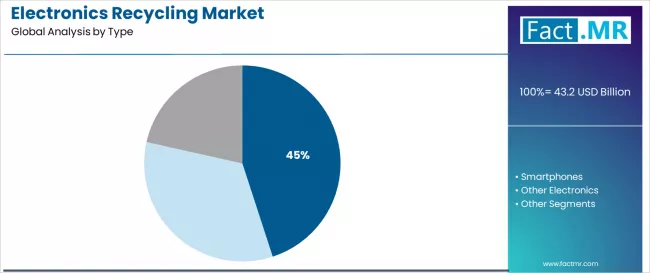
The PCs & laptops segment projects to account for 45.0% of the electronics recycling market in 2025. This reaffirms its position as the leading type category. Recycling operators utilize PC implementations for superior material value standards. Processing system integrators prefer these systems when operating across diverse recovery platforms. Excellent material properties attract users. Widespread acceptance ranges from basic recycling operations to critical processing. PC recycling technology's advanced processing methods address processor requirements for efficient recovery solutions. Complex processing environments benefit from these capabilities.
This type segment forms the foundation of modern electronics recycling adoption patterns. The implementation offers greatest material value. Established market demand exists across multiple electronics categories. Processing segments show strong adoption. Processor investments in PC recycling standardization continue. Recovery efficiency improvements strengthen adoption among recycling producers. Processing companies prioritize value with operational efficiency. PC recycling implementations align with functionality preferences. Performance expectations make these systems central components of comprehensive electronics recycling strategies.
By Process, the Dismantling Segment Accounts for 52.0% Market Share
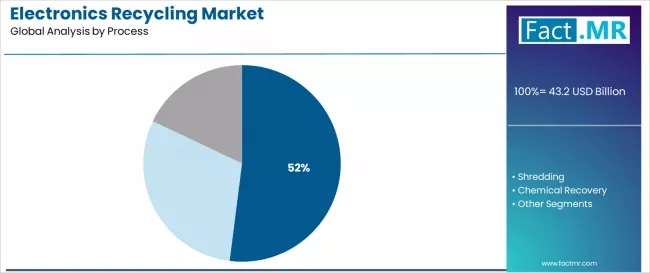
Dismantling of electronics is expected to account for 52.0% of total demand in 2025. This underscores their critical role as primary process for recycling operations. Processing operations use these systems across material recovery applications. Separation operations benefit from processing capabilities. Industrial recycling applications show strong adoption. Processors prefer this process for exceptional precision characteristics.
Scalable processing options appeal to users. Ability to handle diverse material demands while ensuring consistent recovery performance attracts adoption. Various processing platforms benefit from dismantling methods. Essential process for modern recycling operations offers functional advantages.
Value benefits remain important considerations. The segment gains support from continuous innovation in automation technologies. Growing availability of specialized implementations enables diverse processing requirements. Enhanced recovery uniformity capabilities expand applications. Extended processing capabilities attract investment.
Processors invest in advanced dismantling systems supporting large-scale recycling integration. Operational development drives growth. Processing automation trends become prevalent. Processor efficiency awareness increases acceptance. Dismantling applications continue representing major implementation markets. Advanced processing utilization strategies gain support. Recovery integration initiatives expand market reach.
By End-User, the Industrial Segment Accounts for 40.0% Market Share
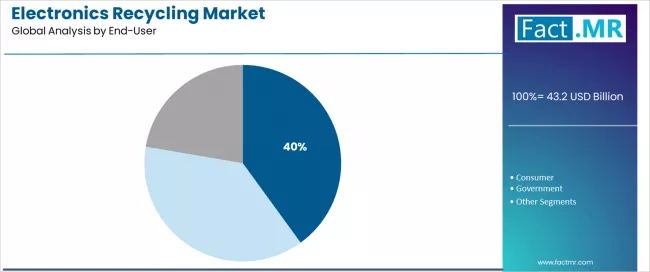
Industrial electronics recycling is projected to represent 40.0% of total demand in 2025. This demonstrates significance as primary deployment sector for recycling systems. Manufacturing operations benefit from resource advantages. Processing facilities show strong adoption. Industrial operators utilize electronics recycling for exceptional efficiency characteristics.
Proven reliability in demanding environments attracts users. Ability to maintain consistent processing performance across diverse operational conditions appeals to processors. The segment's dominance reflects critical nature of resource recovery in industrial operations. Industry commitment to sustainability standards drives adoption.
The industrial sector drives innovation in recycling technology through demanding operational requirements. Stringent efficiency regulations exist. Processors invest heavily in advanced recycling systems ensuring operational continuity. Environmental compliance requirements grow.
Increasing emphasis on circular economy supports market position. Resource management initiatives expand. Industrial applications maintain position as largest end-user segment. Technological advancement initiatives continue. Performance optimization across electronics recycling markets gains momentum.
What are the Drivers, Restraints, and Key Trends of the Electronics Recycling Market?
The electronics recycling market advances rapidly due to increasing electronic waste generation driven by digital transformation acceleration. Consumer device replacement cycles support growth. Growing adoption of recycling systems provides superior recovery characteristics. Environmental benefits enable enhanced sustainability outcomes across diverse electronics applications. Industrial applications expand market reach.
The market faces challenges including complex material separation requirements. Varying contamination levels create processing needs. Specialized technology requirements grow. Supply chain programs become more sophisticated. Innovation in automation processes continues influencing product development. Advanced recovery methods drive market expansion patterns.
Expansion of Digital Transformation and Consumer Electronics Growth
Growing digital transformation sectors enable market development. Advanced electronics consumption capabilities expand applications. Consumer behavior drives processors to produce advanced electronics recycling solutions. Superior recovery positioning attracts users. Enhanced environmental profiles gain acceptance. Seamless integration functionalities expand market reach.
Advanced recycling systems provide improved operational outcomes. More efficient processing workflows develop. Reliable performance across various electronics applications continues. Operating conditions improve with advanced systems. Developers recognize competitive advantages of digital solution integration capabilities. Market differentiation opportunities expand. Recovery positioning becomes increasingly important.
Integration of Artificial Intelligence and Automated Processing
Modern electronics recycling providers incorporate advanced AI technology. Automation system integration expands capabilities. Sophisticated processing solutions enhance service appeal. Intelligent sorting features develop rapidly. Value-added solutions for industrial customers gain acceptance. These technologies improve processing efficiency.
New market opportunities emerge including standardized performance. Optimized recovery enhancement capabilities expand. Enhanced reliability characteristics attract users. Advanced automation integration allows developers supporting comprehensive recycling technologies. Market expansion beyond traditional processing approaches continues.
Analysis of the Electronics Recycling Market by Key Countries
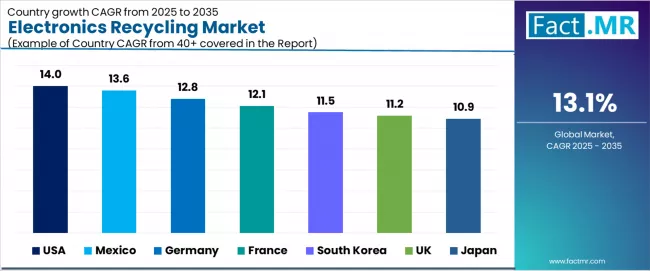
| Country | CAGR (2025-2035) |
|---|---|
| USA | 14.0% |
| Mexico | 13.6% |
| Germany | 12.8% |
| France | 12.1% |
| South Korea | 11.5% |
| UK | 11.2% |
| Japan | 10.9% |
The electronics recycling market experiences exceptional growth globally. The USA leads at 14.0% CAGR through 2035. Expanding e-waste generation drives growth. Growing regulatory enforcement supports development. Significant investment in processing advancement continues. Mexico follows at 13.6%. Increasing electronics consumption supports growth.
Growing manufacturing patterns develop. Expanding recycling infrastructure drives demand. Germany shows growth at 12.8%. Engineering leadership emphasizes development. Processing technology advancement continues. France records 12.1% growth. Expanding recycling capabilities support market development. Environmental system integration modernization continues. South Korea demonstrates 11.5% growth.
Advanced processing technology development occurs. Electronics innovation adoption trends drive market expansion. The UK exhibits 11.2% growth. Processing technology innovation emphasizes development. Industrial advancement continues. Japan shows 10.9% growth. Quality control initiatives support development. Technology-focused production patterns continue.
The report covers in-depth analysis of 40+ countries. Seven top-performing countries receive highlighting below.
USA Leads Global Market Growth with Technology Excellence
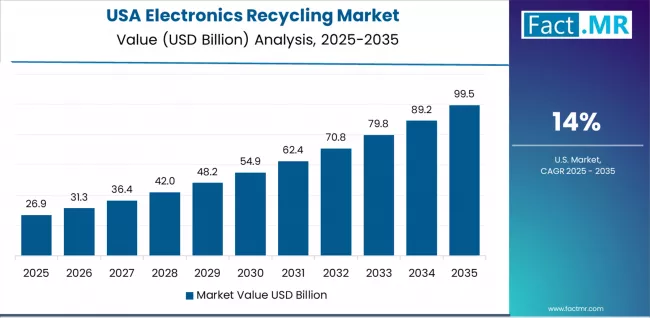
Revenue from electronics recycling in the USA projects exceptional growth with 14.0% CAGR through 2035. Expanding e-waste generation drives development. Rapidly growing regulatory enforcement receives government initiative support promoting sustainable processing. The country's strong position in electronics consumption supports growth. Increasing investment in recycling infrastructure creates substantial demand for advanced implementations. Major technology companies establish comprehensive recycling capabilities. Processing system companies serve domestic recovery demand. Expanding critical materials markets drive growth.
The US leads global market growth due to its massive electronics consumption and strong environmental regulations. The country benefits from EPA e-waste regulations driving recycling adoption. Major factors include rapid technology replacement cycles generating large waste volumes from Silicon Valley tech companies requiring responsible disposal. Growing data center infrastructure from companies like Amazon, Microsoft, and Google requiring equipment recycling.
Federal government initiatives like the National Electronics Recycling Research and Development Initiative promoting electronics stewardship. Strong consumer awareness of environmental issues driven by social media and environmental advocacy. Advanced research institutions like MIT and Stanford developing new recycling technologies. Rising concern over critical materials security affecting national defense. Government incentives like the CHIPS Act for domestic recycling capacity. Major electronics manufacturers like Apple and Dell implementing take-back programs.
Government support for e-waste management initiatives drives demand for advanced recycling systems. Major processing regions benefit from development. Technology centers across the country show expansion. Strong recycling technology growth occurs. Expanding network of sustainability-focused processors supports rapid adoption. Technology operators seek advanced recycling capabilities. Integrated processing technologies gain acceptance.
Mexico Demonstrates Strong Manufacturing Growth with Electronics Expansion
Revenue from electronics recycling in Mexico expands at 13.6% CAGR. The country's growing electronics manufacturing sector supports development. Expanding industrial capacity drives growth. Increasing adoption of recycling technologies continues. Country initiatives promoting manufacturing modernization create demand. Growing environmental awareness drives requirements for quality-controlled recycling systems. International electronics providers establish extensive capabilities. Domestic manufacturing companies address growing demand for advanced recycling solutions.
Mexico shows exceptional growth potential driven by nearshoring trends and electronics manufacturing expansion. The country experiences rapid industrial growth supported by USMCA trade benefits. Key factors include growing electronics manufacturing from companies like Foxconn requiring component recycling. Rising consumer electronics adoption creating domestic e-waste streams. Government programs like the National Program for the Prevention and Integral Management of Waste promoting recycling. Strong maquiladora operations generating industrial electronics waste. Increasing foreign investment in recycling facilities. Growing automotive electronics sector requiring specialized recycling. Strategic location for processing North American e-waste streams. Rising environmental standards following US and Canadian requirements.
Rising electronics manufacturing requirements create opportunities for recycling adoption. Metropolitan production centers show growth. Progressive manufacturers invest in modern recycling facilities. Major industrial regions expand operations. Growing focus on circular economy integration drives adoption. Recycling features appeal to manufacturers seeking enhanced sustainability capabilities. Advanced recovery delivery experiences attract investment.
Germany Demonstrates Engineering Leadership with Circular Economy Innovation
Revenue from electronics recycling in Germany expands at 12.8% CAGR. The country's engineering heritage supports development. Strong emphasis on recycling technology continues. Robust demand for advanced processing systems exists in electronics applications. Environmental applications drive growth. The nation's mature manufacturing sector supports development. Technology-focused operations drive sophisticated implementations throughout the recycling industry. Leading manufacturers invest extensively in technology development. Advanced processing methods serve domestic markets. International markets benefit from German expertise.
Germany maintains its position as Europe's circular economy leader with strong environmental technology focus. The country's Circular Economy Action Plan drives electronics recycling adoption. Growth drivers include world-class electronics industry with companies like Siemens and Bosch generating quality waste streams. Strong environmental regulations like the WEEE Directive requiring proper e-waste disposal. Advanced recycling research at institutions like Fraunhofer Institute developing new recovery technologies. Excellent engineering education producing recycling technology expertise. High investment in Industry 4.0 for automated recycling processes. Strong consumer electronics market generating consistent waste volumes. Advanced materials research supporting precious metal recovery. Well-developed recycling infrastructure throughout the country. Leading position in renewable energy creating additional electronics waste from solar panels and wind turbines.
Rising demand for high-performance recycling technologies creates requirements for sophisticated solutions. Exceptional processing capabilities appeal to quality-conscious manufacturers. Enhanced circular economy experiences gain acceptance. Advanced recycling methods attract investment. Strong engineering tradition supports growth. Growing investment in recycling technologies drives adoption. Quality platforms with advanced development methods appeal to users. Enhanced processing profiles across manufacturing operations expand in major industrial regions.
France Focuses on Environmental Leadership and Technology Integration
Revenue from electronics recycling in France grows at 12.1% CAGR. The country's environmental modernization sector drives development. Growing recycling integration programs support expansion. Increasing investment in sustainable development continues. France's recycling infrastructure supports market growth. Commitment to technological advancement drives demand for diverse recycling solutions. Multiple electronics segments benefit from development. Processors establish comprehensive recycling capabilities. Growing domestic market drives development. Expanding environmental opportunities support growth.
France demonstrates strong growth supported by environmental leadership and EU circular economy initiatives. Key factors include major electronics companies like Thales and STMicroelectronics generating industrial e-waste. Government support for circular economy through France 2030 investment plan allocating significant funding for recycling technologies. Advanced materials research at institutions like CNRS developing new recovery methods. Strong nuclear energy sector generating specialized electronics waste requiring careful handling.
Growing focus on critical materials security following EU Critical Raw Materials Act. Strategic position in European e-waste collection networks. Increasing emphasis on Extended Producer Responsibility requiring manufacturers to fund recycling. Strong retail electronics market from companies like Carrefour implementing take-back programs. Growing adoption of smart city technologies creating new waste streams.
Strong environmental expansion drives adoption of integrated recycling systems. Superior processing capabilities appeal to users. Advanced integration attracts large processors. Progressive recycling companies invest in systems. Growing recovery diversity supports market expansion. Increasing environmental adoption drives advanced implementations. Seamless processing profiles appeal to users. Modern recycling delivery throughout the country's industrial regions gains acceptance.
South Korea Demonstrates Technology Leadership with Electronics Innovation

Revenue from electronics recycling in South Korea grows at 11.5% CAGR. The country's technology integration initiatives drive development. Expanding electronics sector supports growth. Strategic focus on recycling development continues. South Korea's advanced manufacturing capabilities support market expansion. Commitment to electronics modernization drives investment in specialized technologies. Major electronics regions benefit from development. Industry leaders establish comprehensive technology integration systems. Domestic electronics operations benefit from advanced recycling applications.
South Korea exhibits strong growth driven by world-leading electronics industry and technology innovation. Key drivers include major electronics companies like Samsung, LG, and SK Hynix generating massive volumes of production waste and end-of-life products. Government Korean New Deal emphasizing green technology and digital transformation. Strong semiconductor industry creating specialized recycling needs for silicon wafers and rare earth elements.
Advanced display technology sector generating unique waste streams from OLED and LCD production. High consumer electronics replacement rates creating consistent domestic waste volumes. Growing electric vehicle industry with companies like Hyundai requiring battery recycling. Strong automation and robotics capabilities applied to recycling processes. Advanced 5G infrastructure rollout creating telecommunications equipment waste. Government support for urban mining initiatives to recover critical materials.
Innovations in recycling platforms create demand for advanced implementations. Technology integration capabilities attract users. Exceptional processing properties appeal to progressive manufacturers. Enhanced technology differentiation gains acceptance. Operational appeal drives adoption. Growing electronics adoption supports market development. Increasing focus on recycling innovation drives advanced platform adoption. Integrated recovery delivery gains acceptance. Manufacturing optimization across electronics enterprises throughout the country expands market reach.
UK Emphasizes Circular Economy and Resource Security
Revenue from electronics recycling in the UK expands at 11.2% CAGR. The country's advanced recycling technology sector supports development. Strategic focus on circular economy continues. Established processing capabilities drive growth. The UK's recycling system innovation leadership supports market expansion. Environmental technology integration drives demand for specialized implementations in electronics applications. Industrial operations show growth. Advanced sustainability products expand market reach. Processors invest in comprehensive recycling development serving domestic specialty markets. International quality applications benefit from development.
The UK shows strong growth driven by circular economy policies and resource security concerns. Strong electronics industry with companies like ARM Holdings and Rolls-Royce generating high-value e-waste. Key factors include government Circular Economy Package driving sustainable practices. Advanced research institutions like Imperial College London developing new recycling technologies. Post-Brexit focus on domestic resource security and reduced import dependence. Strong emphasis on critical materials recovery following supply chain disruptions.
Growing fintech and digital services sector creating data center waste. Focus on operational efficiency in waste management. Major retailers like Currys implementing comprehensive take-back programs. Growing consumer awareness of environmental issues driving proper disposal.
Circular economy optimization and recycling technology advancement create opportunities for specialized processing adoption in advanced systems. Recovery services benefit from development. Technology-focused operations among leading enterprises gain acceptance. Growing emphasis on advanced recycling delivery drives adoption. Processing features support quality implementations with enhanced technology profiles. Integrated recycling management throughout the country's technology sector expands market reach.
Japan Shows Quality Control Focus and Technology-Driven Processing
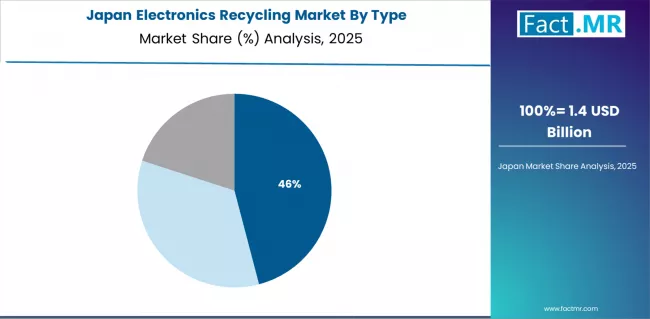
Revenue from electronics recycling in Japan expands at 10.9% CAGR. The country's recycling system excellence initiatives support development. Growing processing technology sector continues expansion. Strategic emphasis on advanced electronics development drives market growth. Japan's advanced quality control capabilities support demand. Integrated recycling systems drive demand for high-quality platforms in electronics operations. Industrial processing applications grow. Advanced technology applications expand market reach. Leading manufacturers invest in specialized capabilities. Technology-focused processing requirements gain attention. Electronics industries demand sophisticated solutions.
Japan shows steady growth supported by precision recycling culture and advanced technology development. Growth factors include highly sophisticated electronics industry with companies like Sony, Panasonic, and Nintendo generating quality waste streams requiring careful processing. Strong emphasis on resource efficiency and circular economy principles following decades of resource scarcity. Advanced separation technologies developed by Japanese companies like Mitsubishi Materials and JX Metals.
Environmental regulations like the Small Home Appliance Recycling Law requiring proper e-waste disposal. Leadership in automation technology applied to recycling processes. Focus on urban mining and resource recovery from electronics waste. High-value electronics like gaming consoles and precision instruments requiring specialized processing. Advanced materials research supporting recovery of rare earth elements and precious metals. Strong tradition of quality control ensuring maximum recovery rates.
Quality control advancement creates requirements for specialized solutions. Superior quality integration appeals to users. Exceptional recycling capabilities attract investment. Advanced recovery features gain acceptance among quality-conscious processing operations. Electronics processors seek sophisticated systems. Strong position in recycling technology innovation supports adoption. Advanced systems with validated processing characteristics gain acceptance. Quality integration capabilities throughout the country's electronics technology sector expand.
Europe Market Split by Country
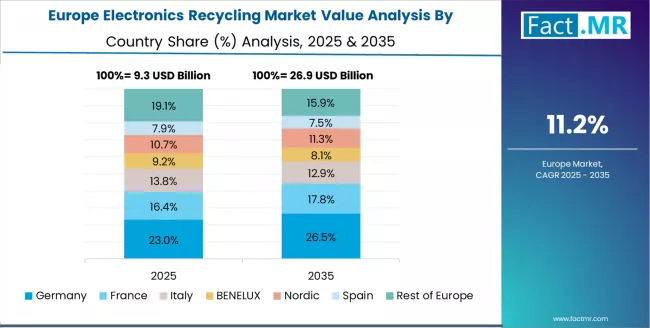
The electronics recycling market in Europe projects growth from USD 12.0 billion in 2025 to USD 41.1 billion by 2035. This registers CAGR of 12.4% over the forecast period. Germany expects to maintain leadership position with 30.8% market share in 2025. This remains stable at 30.7% by 2035. Support comes from strong engineering culture. Sophisticated recycling manufacturing capabilities continue. Comprehensive electronics sector serves diverse applications across Europe.
UK follows with 24.2% share in 2025. This projects to reach 24.4% by 2035. Robust demand for advanced recycling technologies in electronics applications drives growth. Environmental modernization programs support development. Recycling markets benefit from established electronics infrastructure. Technology integration expertise continues.
France holds 20.3% share in 2025. This expects to reach 20.5% by 2035. Strong recycling technology sector supports growth. Growing environmental activities drive development. Other European countries maintain steady growth patterns reflecting regional environmental initiatives and technological advancement in recycling processes.
Competitive Landscape of the Electronics Recycling Market
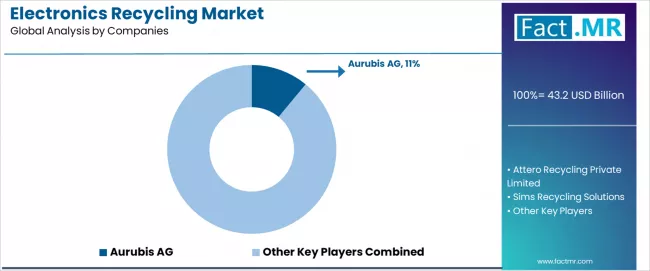
The electronics recycling market demonstrates intense competition among established waste management companies, specialized recycling technology providers, and integrated materials recovery organizations. Companies invest heavily in processing technology research, automation optimization, and advanced separation system development to deliver consistent, high-recovery, and environmentally compliant electronics recycling solutions. Innovation in artificial intelligence applications, precious metal recovery, and circular economy integration remains central to strengthening market position and competitive advantage across global markets.
Aurubis AG leads the market with a substantial 11.0% market share, offering comprehensive recycling solutions including quality recovery platforms and advanced processing systems with particular focus on precious metals and copper recovery applications. The company's strength lies in metallurgical processing innovation, providing integrated solutions that maximize material recovery and environmental compliance.
Attero Recycling provides specialized processing capabilities with strong emphasis on advanced electronics recycling implementations and lithium-ion battery recovery, particularly serving technology and automotive markets. Sims Recycling Solutions delivers comprehensive waste management services with focus on electronics platforms and large-scale processing applications, combining global reach with local processing expertise.
Enviro-Hub specializes in advanced recycling technologies and sustainable implementations for electronics applications, expanding market reach through comprehensive circular economy solutions. Umicore focuses on materials technology integration and precious metal recovery solutions for industrial markets.
Veolia offers integrated waste management platforms with emphasis on sustainable processing, serving both industrial and municipal sectors. The competitive environment also includes significant players like TES-AMM, Dowa, Raw Materials Company, and Recupyl, each focusing on specific market segments and technological specializations in electronics recycling and materials recovery.
The competitive landscape reflects ongoing consolidation as larger waste management companies acquire specialized electronics recycling providers to expand their technology capabilities and market reach. Companies focus on developing integrated solutions that combine electronics recycling with artificial intelligence, blockchain tracking, and advanced materials science to differentiate offerings and capture higher-value market segments.
Strategic partnerships between recyclers and electronics manufacturers drive innovation and market expansion, while increasing emphasis on critical materials security creates opportunities for technology leaders to develop more sophisticated recovery processes and sustainable supply chain solutions.
Key Players in the Electronics Recycling Market
- Aurubis AG
- Attero Recycling Private Limited
- Sims Recycling Solutions
- Enviro-Hub Holdings Ltd.
- Umicore SA
- Veolia
- TES-AMM Japan K.K.
- Dowa Holdings Co., Ltd.
- Recupyl S.A.
Scope of the Report
| Item | Value |
|---|---|
| Quantitative Units | USD 43.2 Billion |
| Type | PCs & laptops; Smartphones; Other electronics |
| Process | Dismantling; Shredding; Chemical recovery |
| End-User | Industrial; Consumer; Government |
| Regions Covered | North America; Europe; Asia-Pacific; Latin America; Middle East & Africa |
| Countries Covered | USA; Germany; France; UK; Japan; South Korea; Mexico; and 40+ additional countries |
| Key Companies Profiled | Aurubis AG; Attero Recycling; Sims Recycling Solutions; Enviro-Hub; Umicore; Veolia |
| Additional Attributes | Dollar sales by type and process category; regional demand trends; competitive landscape; technological advancements in recycling engineering; automation development; sustainability innovation; circular economy integration protocols |
Electronics Recycling Market by Segments
-
Type :
- PCs & Laptops
- Smartphones
- Other Electronics
-
Process :
- Dismantling
- Shredding
- Chemical Recovery
-
End-User :
- Industrial
- Consumer
- Government
-
Region :
-
North America
- USA
- Canada
- Mexico
-
Europe
- Germany
- UK
- France
- Italy
- Spain
- Rest of Europe
-
Asia-Pacific
- China
- Japan
- South Korea
- India
- Australia
- Rest of Asia-Pacific
-
Latin America
- Brazil
- Argentina
- Rest of Latin America
-
Middle East & Africa
- Saudi Arabia
- UAE
- South Africa
- Rest of Middle East & Africa
-
Table of Content
- Executive Summary
- Global Market Outlook
- Demand to side Trends
- Supply to side Trends
- Technology Roadmap Analysis
- Analysis and Recommendations
- Market Overview
- Market Coverage / Taxonomy
- Market Definition / Scope / Limitations
- Market Background
- Market Dynamics
- Drivers
- Restraints
- Opportunity
- Trends
- Scenario Forecast
- Demand in Optimistic Scenario
- Demand in Likely Scenario
- Demand in Conservative Scenario
- Opportunity Map Analysis
- Product Life Cycle Analysis
- Supply Chain Analysis
- Investment Feasibility Matrix
- Value Chain Analysis
- PESTLE and Porter’s Analysis
- Regulatory Landscape
- Regional Parent Market Outlook
- Production and Consumption Statistics
- Import and Export Statistics
- Market Dynamics
- Global Market Analysis 2020 to 2024 and Forecast, 2025 to 2035
- Historical Market Size Value (USD Million) Analysis, 2020 to 2024
- Current and Future Market Size Value (USD Million) Projections, 2025 to 2035
- Y to o to Y Growth Trend Analysis
- Absolute $ Opportunity Analysis
- Global Market Pricing Analysis 2020 to 2024 and Forecast 2025 to 2035
- Global Market Analysis 2020 to 2024 and Forecast 2025 to 2035, By Type
- Introduction / Key Findings
- Historical Market Size Value (USD Million) Analysis By Type, 2020 to 2024
- Current and Future Market Size Value (USD Million) Analysis and Forecast By Type, 2025 to 2035
- PCs & Laptops
- Smartphones
- Other Electronics
- Y to o to Y Growth Trend Analysis By Type, 2020 to 2024
- Absolute $ Opportunity Analysis By Type, 2025 to 2035
- Global Market Analysis 2020 to 2024 and Forecast 2025 to 2035, By Process
- Introduction / Key Findings
- Historical Market Size Value (USD Million) Analysis By Process, 2020 to 2024
- Current and Future Market Size Value (USD Million) Analysis and Forecast By Process, 2025 to 2035
- Dismantling
- Shredding
- Chemical Recovery
- Y to o to Y Growth Trend Analysis By Process, 2020 to 2024
- Absolute $ Opportunity Analysis By Process, 2025 to 2035
- Global Market Analysis 2020 to 2024 and Forecast 2025 to 2035, By End-User
- Introduction / Key Findings
- Historical Market Size Value (USD Million) Analysis By End-User, 2020 to 2024
- Current and Future Market Size Value (USD Million) Analysis and Forecast By End-User, 2025 to 2035
- Industrial
- Consumer
- Government
- Y to o to Y Growth Trend Analysis By End-User, 2020 to 2024
- Absolute $ Opportunity Analysis By End-User, 2025 to 2035
- Global Market Analysis 2020 to 2024 and Forecast 2025 to 2035, By Region
- Introduction
- Historical Market Size Value (USD Million) Analysis By Region, 2020 to 2024
- Current Market Size Value (USD Million) Analysis and Forecast By Region, 2025 to 2035
- North America
- Latin America
- Western Europe
- Eastern Europe
- East Asia
- South Asia and Pacific
- Middle East & Africa
- Market Attractiveness Analysis By Region
- North America Market Analysis 2020 to 2024 and Forecast 2025 to 2035, By Country
- Historical Market Size Value (USD Million) Trend Analysis By Market Taxonomy, 2020 to 2024
- Market Size Value (USD Million) Forecast By Market Taxonomy, 2025 to 2035
- By Country
- USA
- Canada
- Mexico
- By Type
- By Process
- By End-User
- By Country
- Market Attractiveness Analysis
- By Country
- By Type
- By Process
- By End-User
- Key Takeaways
- Latin America Market Analysis 2020 to 2024 and Forecast 2025 to 2035, By Country
- Historical Market Size Value (USD Million) Trend Analysis By Market Taxonomy, 2020 to 2024
- Market Size Value (USD Million) Forecast By Market Taxonomy, 2025 to 2035
- By Country
- Brazil
- Chile
- Rest of Latin America
- By Type
- By Process
- By End-User
- By Country
- Market Attractiveness Analysis
- By Country
- By Type
- By Process
- By End-User
- Key Takeaways
- Western Europe Market Analysis 2020 to 2024 and Forecast 2025 to 2035, By Country
- Historical Market Size Value (USD Million) Trend Analysis By Market Taxonomy, 2020 to 2024
- Market Size Value (USD Million) Forecast By Market Taxonomy, 2025 to 2035
- By Country
- Germany
- UK
- Italy
- Spain
- France
- Nordic
- BENELUX
- Rest of Western Europe
- By Type
- By Process
- By End-User
- By Country
- Market Attractiveness Analysis
- By Country
- By Type
- By Process
- By End-User
- Key Takeaways
- Eastern Europe Market Analysis 2020 to 2024 and Forecast 2025 to 2035, By Country
- Historical Market Size Value (USD Million) Trend Analysis By Market Taxonomy, 2020 to 2024
- Market Size Value (USD Million) Forecast By Market Taxonomy, 2025 to 2035
- By Country
- Russia
- Poland
- Hungary
- Balkan & Baltic
- Rest of Eastern Europe
- By Type
- By Process
- By End-User
- By Country
- Market Attractiveness Analysis
- By Country
- By Type
- By Process
- By End-User
- Key Takeaways
- East Asia Market Analysis 2020 to 2024 and Forecast 2025 to 2035, By Country
- Historical Market Size Value (USD Million) Trend Analysis By Market Taxonomy, 2020 to 2024
- Market Size Value (USD Million) Forecast By Market Taxonomy, 2025 to 2035
- By Country
- China
- Japan
- South Korea
- By Type
- By Process
- By End-User
- By Country
- Market Attractiveness Analysis
- By Country
- By Type
- By Process
- By End-User
- Key Takeaways
- South Asia and Pacific Market Analysis 2020 to 2024 and Forecast 2025 to 2035, By Country
- Historical Market Size Value (USD Million) Trend Analysis By Market Taxonomy, 2020 to 2024
- Market Size Value (USD Million) Forecast By Market Taxonomy, 2025 to 2035
- By Country
- India
- ASEAN
- Australia & New Zealand
- Rest of South Asia and Pacific
- By Type
- By Process
- By End-User
- By Country
- Market Attractiveness Analysis
- By Country
- By Type
- By Process
- By End-User
- Key Takeaways
- Middle East & Africa Market Analysis 2020 to 2024 and Forecast 2025 to 2035, By Country
- Historical Market Size Value (USD Million) Trend Analysis By Market Taxonomy, 2020 to 2024
- Market Size Value (USD Million) Forecast By Market Taxonomy, 2025 to 2035
- By Country
- Kingdom of Saudi Arabia
- Other GCC Countries
- Turkiye
- South Africa
- Other African Union
- Rest of Middle East & Africa
- By Type
- By Process
- By End-User
- By Country
- Market Attractiveness Analysis
- By Country
- By Type
- By Process
- By End-User
- Key Takeaways
- Key Countries Market Analysis
- USA
- Pricing Analysis
- Market Share Analysis, 2024
- By Type
- By Process
- By End-User
- Canada
- Pricing Analysis
- Market Share Analysis, 2024
- By Type
- By Process
- By End-User
- Mexico
- Pricing Analysis
- Market Share Analysis, 2024
- By Type
- By Process
- By End-User
- Brazil
- Pricing Analysis
- Market Share Analysis, 2024
- By Type
- By Process
- By End-User
- Chile
- Pricing Analysis
- Market Share Analysis, 2024
- By Type
- By Process
- By End-User
- Germany
- Pricing Analysis
- Market Share Analysis, 2024
- By Type
- By Process
- By End-User
- UK
- Pricing Analysis
- Market Share Analysis, 2024
- By Type
- By Process
- By End-User
- Italy
- Pricing Analysis
- Market Share Analysis, 2024
- By Type
- By Process
- By End-User
- Spain
- Pricing Analysis
- Market Share Analysis, 2024
- By Type
- By Process
- By End-User
- France
- Pricing Analysis
- Market Share Analysis, 2024
- By Type
- By Process
- By End-User
- India
- Pricing Analysis
- Market Share Analysis, 2024
- By Type
- By Process
- By End-User
- ASEAN
- Pricing Analysis
- Market Share Analysis, 2024
- By Type
- By Process
- By End-User
- Australia & New Zealand
- Pricing Analysis
- Market Share Analysis, 2024
- By Type
- By Process
- By End-User
- China
- Pricing Analysis
- Market Share Analysis, 2024
- By Type
- By Process
- By End-User
- Japan
- Pricing Analysis
- Market Share Analysis, 2024
- By Type
- By Process
- By End-User
- South Korea
- Pricing Analysis
- Market Share Analysis, 2024
- By Type
- By Process
- By End-User
- Russia
- Pricing Analysis
- Market Share Analysis, 2024
- By Type
- By Process
- By End-User
- Poland
- Pricing Analysis
- Market Share Analysis, 2024
- By Type
- By Process
- By End-User
- Hungary
- Pricing Analysis
- Market Share Analysis, 2024
- By Type
- By Process
- By End-User
- Kingdom of Saudi Arabia
- Pricing Analysis
- Market Share Analysis, 2024
- By Type
- By Process
- By End-User
- Turkiye
- Pricing Analysis
- Market Share Analysis, 2024
- By Type
- By Process
- By End-User
- South Africa
- Pricing Analysis
- Market Share Analysis, 2024
- By Type
- By Process
- By End-User
- USA
- Market Structure Analysis
- Competition Dashboard
- Competition Benchmarking
- Market Share Analysis of Top Players
- By Regional
- By Type
- By Process
- By End-User
- Competition Analysis
- Competition Deep Dive
- Aurubis AG
- Overview
- Product Portfolio
- Profitability by Market Segments (Product/Age /Sales Channel/Region)
- Sales Footprint
- Strategy Overview
- Marketing Strategy
- Product Strategy
- Channel Strategy
- Attero Recycling Private Limited
- Sims Recycling Solutions
- Enviro-Hub Holdings Ltd.
- Umicore SA
- Veolia
- TES-AMM Japan K.K.
- Dowa Holdings Co., Ltd.
- Recupyl S.A.
- Aurubis AG
- Competition Deep Dive
- Assumptions & Acronyms Used
- Research Methodology
List Of Table
- Table 1: Global Market Value (USD Million) Forecast by Region, 2020 to 2035
- Table 2: Global Market Value (USD Million) Forecast by Type, 2020 to 2035
- Table 3: Global Market Value (USD Million) Forecast by Process, 2020 to 2035
- Table 4: Global Market Value (USD Million) Forecast by End-User, 2020 to 2035
- Table 5: North America Market Value (USD Million) Forecast by Country, 2020 to 2035
- Table 6: North America Market Value (USD Million) Forecast by Type, 2020 to 2035
- Table 7: North America Market Value (USD Million) Forecast by Process, 2020 to 2035
- Table 8: North America Market Value (USD Million) Forecast by End-User, 2020 to 2035
- Table 9: Latin America Market Value (USD Million) Forecast by Country, 2020 to 2035
- Table 10: Latin America Market Value (USD Million) Forecast by Type, 2020 to 2035
- Table 11: Latin America Market Value (USD Million) Forecast by Process, 2020 to 2035
- Table 12: Latin America Market Value (USD Million) Forecast by End-User, 2020 to 2035
- Table 13: Western Europe Market Value (USD Million) Forecast by Country, 2020 to 2035
- Table 14: Western Europe Market Value (USD Million) Forecast by Type, 2020 to 2035
- Table 15: Western Europe Market Value (USD Million) Forecast by Process, 2020 to 2035
- Table 16: Western Europe Market Value (USD Million) Forecast by End-User, 2020 to 2035
- Table 17: Eastern Europe Market Value (USD Million) Forecast by Country, 2020 to 2035
- Table 18: Eastern Europe Market Value (USD Million) Forecast by Type, 2020 to 2035
- Table 19: Eastern Europe Market Value (USD Million) Forecast by Process, 2020 to 2035
- Table 20: Eastern Europe Market Value (USD Million) Forecast by End-User, 2020 to 2035
- Table 21: East Asia Market Value (USD Million) Forecast by Country, 2020 to 2035
- Table 22: East Asia Market Value (USD Million) Forecast by Type, 2020 to 2035
- Table 23: East Asia Market Value (USD Million) Forecast by Process, 2020 to 2035
- Table 24: East Asia Market Value (USD Million) Forecast by End-User, 2020 to 2035
- Table 25: South Asia and Pacific Market Value (USD Million) Forecast by Country, 2020 to 2035
- Table 26: South Asia and Pacific Market Value (USD Million) Forecast by Type, 2020 to 2035
- Table 27: South Asia and Pacific Market Value (USD Million) Forecast by Process, 2020 to 2035
- Table 28: South Asia and Pacific Market Value (USD Million) Forecast by End-User, 2020 to 2035
- Table 29: Middle East & Africa Market Value (USD Million) Forecast by Country, 2020 to 2035
- Table 30: Middle East & Africa Market Value (USD Million) Forecast by Type, 2020 to 2035
- Table 31: Middle East & Africa Market Value (USD Million) Forecast by Process, 2020 to 2035
- Table 32: Middle East & Africa Market Value (USD Million) Forecast by End-User, 2020 to 2035
List Of Figures
- Figure 1: Global Market Pricing Analysis
- Figure 2: Global Market Value (USD Million) Forecast 2020-2035
- Figure 3: Global Market Value Share and BPS Analysis by Type, 2025 and 2035
- Figure 4: Global Market Y to o to Y Growth Comparison by Type, 2025-2035
- Figure 5: Global Market Attractiveness Analysis by Type
- Figure 6: Global Market Value Share and BPS Analysis by Process, 2025 and 2035
- Figure 7: Global Market Y to o to Y Growth Comparison by Process, 2025-2035
- Figure 8: Global Market Attractiveness Analysis by Process
- Figure 9: Global Market Value Share and BPS Analysis by End-User, 2025 and 2035
- Figure 10: Global Market Y to o to Y Growth Comparison by End-User, 2025-2035
- Figure 11: Global Market Attractiveness Analysis by End-User
- Figure 12: Global Market Value (USD Million) Share and BPS Analysis by Region, 2025 and 2035
- Figure 13: Global Market Y to o to Y Growth Comparison by Region, 2025-2035
- Figure 14: Global Market Attractiveness Analysis by Region
- Figure 15: North America Market Incremental Dollar Opportunity, 2025-2035
- Figure 16: Latin America Market Incremental Dollar Opportunity, 2025-2035
- Figure 17: Western Europe Market Incremental Dollar Opportunity, 2025-2035
- Figure 18: Eastern Europe Market Incremental Dollar Opportunity, 2025-2035
- Figure 19: East Asia Market Incremental Dollar Opportunity, 2025-2035
- Figure 20: South Asia and Pacific Market Incremental Dollar Opportunity, 2025-2035
- Figure 21: Middle East & Africa Market Incremental Dollar Opportunity, 2025-2035
- Figure 22: North America Market Value Share and BPS Analysis by Country, 2025 and 2035
- Figure 23: North America Market Value Share and BPS Analysis by Type, 2025 and 2035
- Figure 24: North America Market Y to o to Y Growth Comparison by Type, 2025-2035
- Figure 25: North America Market Attractiveness Analysis by Type
- Figure 26: North America Market Value Share and BPS Analysis by Process, 2025 and 2035
- Figure 27: North America Market Y to o to Y Growth Comparison by Process, 2025-2035
- Figure 28: North America Market Attractiveness Analysis by Process
- Figure 29: North America Market Value Share and BPS Analysis by End-User, 2025 and 2035
- Figure 30: North America Market Y to o to Y Growth Comparison by End-User, 2025-2035
- Figure 31: North America Market Attractiveness Analysis by End-User
- Figure 32: Latin America Market Value Share and BPS Analysis by Country, 2025 and 2035
- Figure 33: Latin America Market Value Share and BPS Analysis by Type, 2025 and 2035
- Figure 34: Latin America Market Y to o to Y Growth Comparison by Type, 2025-2035
- Figure 35: Latin America Market Attractiveness Analysis by Type
- Figure 36: Latin America Market Value Share and BPS Analysis by Process, 2025 and 2035
- Figure 37: Latin America Market Y to o to Y Growth Comparison by Process, 2025-2035
- Figure 38: Latin America Market Attractiveness Analysis by Process
- Figure 39: Latin America Market Value Share and BPS Analysis by End-User, 2025 and 2035
- Figure 40: Latin America Market Y to o to Y Growth Comparison by End-User, 2025-2035
- Figure 41: Latin America Market Attractiveness Analysis by End-User
- Figure 42: Western Europe Market Value Share and BPS Analysis by Country, 2025 and 2035
- Figure 43: Western Europe Market Value Share and BPS Analysis by Type, 2025 and 2035
- Figure 44: Western Europe Market Y to o to Y Growth Comparison by Type, 2025-2035
- Figure 45: Western Europe Market Attractiveness Analysis by Type
- Figure 46: Western Europe Market Value Share and BPS Analysis by Process, 2025 and 2035
- Figure 47: Western Europe Market Y to o to Y Growth Comparison by Process, 2025-2035
- Figure 48: Western Europe Market Attractiveness Analysis by Process
- Figure 49: Western Europe Market Value Share and BPS Analysis by End-User, 2025 and 2035
- Figure 50: Western Europe Market Y to o to Y Growth Comparison by End-User, 2025-2035
- Figure 51: Western Europe Market Attractiveness Analysis by End-User
- Figure 52: Eastern Europe Market Value Share and BPS Analysis by Country, 2025 and 2035
- Figure 53: Eastern Europe Market Value Share and BPS Analysis by Type, 2025 and 2035
- Figure 54: Eastern Europe Market Y to o to Y Growth Comparison by Type, 2025-2035
- Figure 55: Eastern Europe Market Attractiveness Analysis by Type
- Figure 56: Eastern Europe Market Value Share and BPS Analysis by Process, 2025 and 2035
- Figure 57: Eastern Europe Market Y to o to Y Growth Comparison by Process, 2025-2035
- Figure 58: Eastern Europe Market Attractiveness Analysis by Process
- Figure 59: Eastern Europe Market Value Share and BPS Analysis by End-User, 2025 and 2035
- Figure 60: Eastern Europe Market Y to o to Y Growth Comparison by End-User, 2025-2035
- Figure 61: Eastern Europe Market Attractiveness Analysis by End-User
- Figure 62: East Asia Market Value Share and BPS Analysis by Country, 2025 and 2035
- Figure 63: East Asia Market Value Share and BPS Analysis by Type, 2025 and 2035
- Figure 64: East Asia Market Y to o to Y Growth Comparison by Type, 2025-2035
- Figure 65: East Asia Market Attractiveness Analysis by Type
- Figure 66: East Asia Market Value Share and BPS Analysis by Process, 2025 and 2035
- Figure 67: East Asia Market Y to o to Y Growth Comparison by Process, 2025-2035
- Figure 68: East Asia Market Attractiveness Analysis by Process
- Figure 69: East Asia Market Value Share and BPS Analysis by End-User, 2025 and 2035
- Figure 70: East Asia Market Y to o to Y Growth Comparison by End-User, 2025-2035
- Figure 71: East Asia Market Attractiveness Analysis by End-User
- Figure 72: South Asia and Pacific Market Value Share and BPS Analysis by Country, 2025 and 2035
- Figure 73: South Asia and Pacific Market Value Share and BPS Analysis by Type, 2025 and 2035
- Figure 74: South Asia and Pacific Market Y to o to Y Growth Comparison by Type, 2025-2035
- Figure 75: South Asia and Pacific Market Attractiveness Analysis by Type
- Figure 76: South Asia and Pacific Market Value Share and BPS Analysis by Process, 2025 and 2035
- Figure 77: South Asia and Pacific Market Y to o to Y Growth Comparison by Process, 2025-2035
- Figure 78: South Asia and Pacific Market Attractiveness Analysis by Process
- Figure 79: South Asia and Pacific Market Value Share and BPS Analysis by End-User, 2025 and 2035
- Figure 80: South Asia and Pacific Market Y to o to Y Growth Comparison by End-User, 2025-2035
- Figure 81: South Asia and Pacific Market Attractiveness Analysis by End-User
- Figure 82: Middle East & Africa Market Value Share and BPS Analysis by Country, 2025 and 2035
- Figure 83: Middle East & Africa Market Value Share and BPS Analysis by Type, 2025 and 2035
- Figure 84: Middle East & Africa Market Y to o to Y Growth Comparison by Type, 2025-2035
- Figure 85: Middle East & Africa Market Attractiveness Analysis by Type
- Figure 86: Middle East & Africa Market Value Share and BPS Analysis by Process, 2025 and 2035
- Figure 87: Middle East & Africa Market Y to o to Y Growth Comparison by Process, 2025-2035
- Figure 88: Middle East & Africa Market Attractiveness Analysis by Process
- Figure 89: Middle East & Africa Market Value Share and BPS Analysis by End-User, 2025 and 2035
- Figure 90: Middle East & Africa Market Y to o to Y Growth Comparison by End-User, 2025-2035
- Figure 91: Middle East & Africa Market Attractiveness Analysis by End-User
- Figure 92: Global Market - Tier Structure Analysis
- Figure 93: Global Market - Company Share Analysis
- FAQs -
How big is the electronics recycling market in 2025?
The global electronics recycling market is estimated to be valued at USD 43.2 billion in 2025.
What will be the size of electronics recycling market in 2035?
The market size for the electronics recycling market is projected to reach USD 147.9 billion by 2035.
How much will be the electronics recycling market growth between 2025 and 2035?
The electronics recycling market is expected to grow at a 13.1% CAGR between 2025 and 2035.
What are the key product types in the electronics recycling market?
The key product types in electronics recycling market are pcs & laptops, smartphones and other electronics.
Which process segment to contribute significant share in the electronics recycling market in 2025?
In terms of process, dismantling segment to command 52.0% share in the electronics recycling market in 2025.